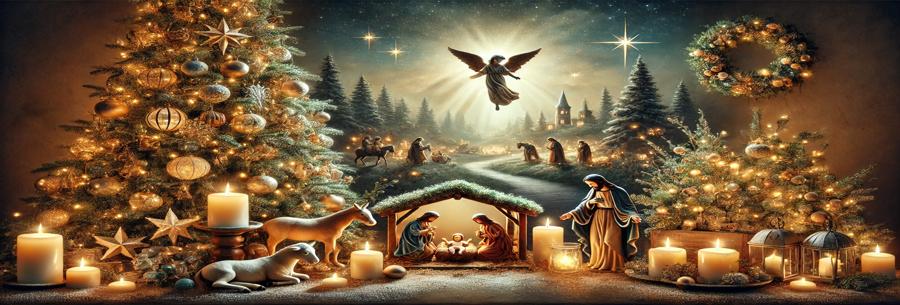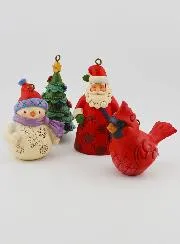A spiritual journey through traditions
Christmas, beyond its festive and family aspect, is a celebration deeply rooted in the Christian faith. The decorations that adorn our homes, churches and public squares are not mere ornaments; they are imbued with spiritual symbols that reflect the message of the Nativity and Christian teachings. This article explores in depth the symbolic richness of Christmas decorations, from their Christian origins to their spiritual significance.
The Christmas tree: Symbol of eternal life
The Christmas tree is one of the most emblematic decorations, but its spiritual origins are sometimes misunderstood.
Christian origins:
The fir tree, an evergreen, was adopted by the first Christians to symbolise the eternal life offered by Jesus Christ. In the 8th century, Saint Boniface, a missionary in Germania, is said to have used the fir tree to teach about the Trinity, replacing the pagan rites linked to the sacred oak.
Christian symbolism:
The triangular shape of the tree recalls the Holy Trinity (Father, Son and Holy Spirit). The branches that remain green in winter symbolise hope and the persistence of faith.
Candles and lights: the light of Christ
Candles, fairy lights and other lighting occupy a central place in Christmas decorations.
An ancient tradition:
In ancient Christian celebrations, candles symbolised Jesus as "the light of the world" (John 8:12). The use of lights at Christmas is also linked to the feast of Saint Lucia, celebrated in the Nordic countries.
A light in the darkness:
Candles and lights recall the victory of divine light over the darkness of sin and death.
Stars: The Star of Bethlehem
The star, often placed at the top of the tree or incorporated into the decorations, refers to the Star of Bethlehem that guided the Magi to Jesus.
Spiritual significance:
The star represents divine guidance and the call to follow the light of Christ. It also symbolises Jesus' universal mission, attracting people from all nations, represented by the Magi.
Modern variations:
The twinkling stars in garlands or decorations evoke divine promises and the hope of a future illuminated by faith.Modern string lights extend this symbolism by illuminating homes and streets, a call to joy and hope.
The cot: the central representation of the Nativity
The cot is undoubtedly the element most directly linked to the Christian Christmas story.
A tradition initiated by Saint Francis of Assisi:
In 1223, Saint Francis of Assisi is said to have created the first living cot to make the Nativity more tangible for the faithful. Since then, cots, whether living, sculpted or miniature, have become a universal tradition.
Theological significance:
Each element of the cot has a symbolic significance:
The stable: The humility and simplicity of Jesus' birth.
The ox and donkey: The recognition of divinity by all creation.
The shepherds: The call to the humble and marginalised to welcome the Good News.
The wreaths and boughs of holly: The circle of eternal life
Advent wreaths and boughs of holly are decorative elements rich in Christian symbolism.
The Advent wreath:
Shaped like a circle, the wreath represents eternity and God's infinite love. The four candles lit each week of Advent symbolise hope, peace, joy and love.
The holly:
The evergreen leaves symbolise eternal life. The red berries recall the blood of Christ shed for the redemption of mankind.
Angels: Messengers of the Good News
Angels are ubiquitous in Christmas decorations, from figurines to motifs on cards and ornaments.
Role in the biblical story:
Angels announce the birth of Jesus to the shepherds, proclaiming "Glory to God in the highest" (Luke 2:14). They symbolise the connection between heaven and earth.
Signification in decorations:
Angels recall the role of divine messengers in our lives, bearers of hope and protection.
Christmas gifts and stockings: The exchange of love and gratitude
The exchange of gifts, although often perceived as a commercial practice, has roots in Christian tradition.
Inspiration of the Magi: The three Magi offer Jesus gold, frankincense and myrrh, symbolising his kingship, divinity and future suffering respectively.
Spiritual significance: The gifts are a reminder of the love of God, who offered his only Son as the greatest gift.
Christmas stockings, hung by the fireplace, are linked to the story of St Nicholas, who is said to have secretly left gifts in socks.
Bells and carols : The call to celebrate
Christmas bells and carols ring out around the world, marking the joy of Christ's birth.
Bells: They symbolise the call to prayer and celebration.
In some traditions, bells are believed to drive away evil spirits and herald the coming of light.
Carols: Christmas carols, such as Douce Nuit or Angels We Have Heard on High, convey the joy and praise of Christmas.
Christmas decorations, often perceived as mere festive elements, are in fact imbued with rich Christian symbolism. They remind us that Christmas is above all a spiritual celebration, a time to meditate on the love, light and redemption offered by the birth of Jesus Christ. By rediscovering these profound meanings, we can live this season with a renewed sense of gratitude and faith.




















